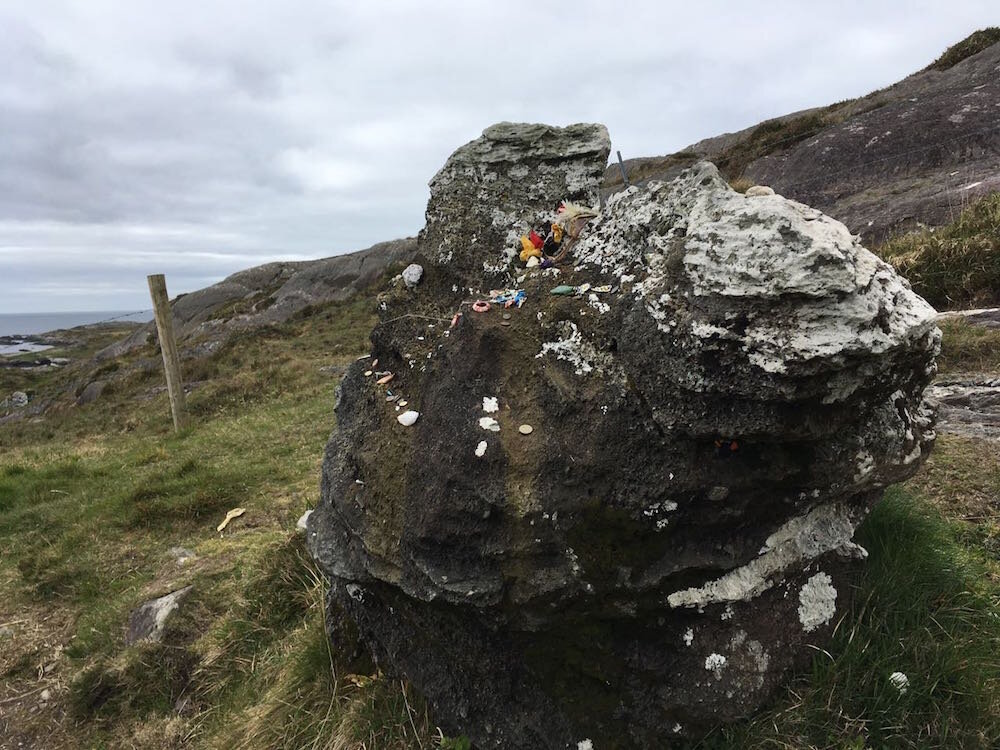Following Folklore & the Cailleach
Sitting in a traditional Irish pub, with polished brass and worn wood, I scarf down a large plate of fish and chips after a long day of hiking. A couple of locals start chatting. “Why are you here?” they ask with kindly curiosity and slight befuddlement. A fair question - I’m a Canadian at the edge of the world in the wild, craggy, mountainous lands of the beautiful Beara Peninsula in Ireland. Through my mind flashes my long, and at times intense, journey of wellness, self discovery, and learning about my ancestry. I reply simply: “I’m following folklore.”
To give shape and purpose to my six month Grand Adventure through the UK and Ireland, I chose to be in places of folklore, as well as places of colonial resistance and cultural resurgence. There’s a lovely Celtic belief that if you sleep on the land, it may reveal itself and its history to you. With this in mind, I’ve chosen to root in places, breaking the cardinal rule of tourists to try and see as much as you can in what time you have. Rooting lets the land unfold, and you can learn so much as its layers are revealed. It can allow you a depth of connection with people and place.
Knowing the Cailleach
An Chailleach Bhéara, Eyeries, Ireland
Stories of the Cailleach are found all over Ireland, Scotland, Brittany and the Isle of Man. The Beara Peninsula is particularly filled with her tales.
The Cailleach is an ancient goddess, divine Hag, the original creator. A giantess, she strode across the land, shaping it as she went. Often a solitary figure, her places are wild and rugged and of high ground. She’s one with nature and it’s caretaker, the guardian of wild animals, and connected with deer and the cow. She rules storms, weather and winter, and balance is found with her sister Brìghde, who rules the summer. In some stories, they are one in the same. Teachings abound in her mythology, and I’m drawn to how they show us how to be with the land, work with it, and care for it. Her stories also teach us about self-care and renewal. A reminder that regardless of who we are, upkeep of our wellbeing is a continual and necessary process.
Stories of the Cailleach are so old that they shift over time, changing with the culture and ideologies of the day. In later stories, we see how the introduction of the church, patriarchal structures, and pastoral culture turn her into little more than a wicked witch, a straw doll, and a pillar of stone. Gearóid Ó Crualaoich has pulled together a brilliant collection of tales, explaining such shifts over time. In her writings and courses, Sharon Blackie does an incredible job of bringing the stories of the Cailleach to life. It was such a treasure to attend one of her creative retreats, visit her new Hedge School, and get some great pointers from her on where to find the Hag in Beara.
Cailleach & Creation, watercolour on paper, by Sarah West, 12 x 9”, 2016
Following Folklore
Tooth Mountain, Ireland
I followed folklore and the Cailleach all across Beara, and it led me on incredible adventures to the wildest of places.
I climbed over the mountains of Allihies, where you could almost see her stony face, smiling towards the sky. I trekked into a remote and deserted valley, and when the mountains allowed you to go no further, you could see the “hag’s tooth” jutting out far above. Down Tooth Mountain, her cool breath rolled. I swung in a cable car across to Dursey Island, which has strong associations with the Cailleach. I happened on one of three days in the year where the locals move their livestock on and off the island in a flat bottomed ferry. A shepherdess herded her riled sheep over the hills, disappearing into the mists… maybe not unlike how the Cailleach shepherds the deer. Just outside of Eyeries, I sat with An Chailleach Bhéara (Hag of Beara), who was turned into a pillar of stone as punishment for stealing a prayer book.
Sipping tea and nibbling on endless biscuits, I chatted for ages with new friends and fellow lovers of folklore about the Cailleach and the stories connected to the land. I shyly showed them the painting I did of the Cailleach a year prior. As they live in a land so thick with her stories, their opinion mattered a great deal. It was my first watercolour and attempt to portray the folklore I was learning. Possibly they were being polite, but I was pleased they seemed to genuinely liked it. In a slightly ridiculous turn of events, I also stumbled upon an unprepared film crew, making a travel documentary on legends. They asked me to tour them about and filmed me telling stories, and in return, I asked them to do the stories justice.
Over the beginning of May (Bealtaine), I prepared to leave Beara for Scotland. Wild winds whipped and rains raged. This weather is said to be the Cailleach’s last attempts to hold on to winter, as spring and Brìghde draws increasing strength to bring the land back to life. Inside, I raged a little as well, reluctant to leave, knowing it was time to carry on my journey.
Knockgour Mountain, Allihies, Ireland




